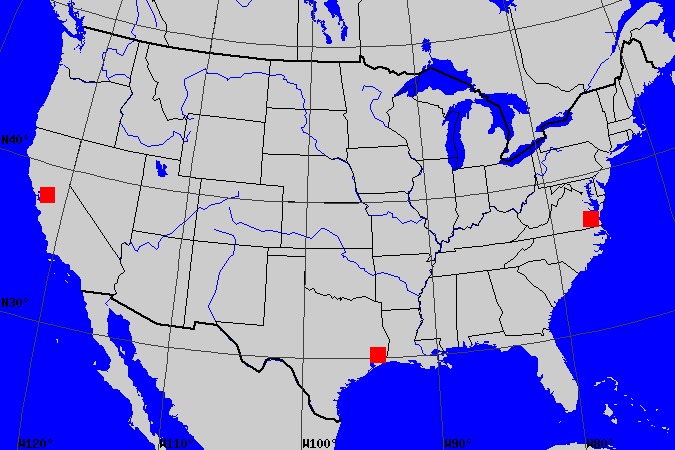



National Defense Reserve Fleet (NDRF)
The Merchant Ship Sales Act of 1946 created a Government owned and administered National Defense Reserve Fleet (NDRF) of inactive but potentially militarily useful merchant ships. National Defense Reserve Fleet ships serve as an inactive reserve of vessels which can be activate to help meet U. S. shipping requirements during a national emergency. . NDRF sites were originally located at Stoney Point, N.Y.; Fort Eustis, (James River) Va.; Wilmington, N.C.; Mobile, Ala.; Beaumont, (Neches River) Texas; Benicia, (Suisun Bay) Calif.; Astoria, Ore.; and Olympia, Wash.
At its peak, 2,277 ships were in lay-up. Currently, MARAD maintains inactive merchant ships and naval auxiliaries in three reserve fleet sites: 98 were located at Ft. Eustis, VA; 49 at Beaumont, TX and 84 at Suisun Bay, CA. The remaining vessels are either under contract in major U.S. port cities, or they are at-sea on DOD missions.
A Ready Reserve Fleet component was established in 1976 as a subset of the NDRF
to provide rapid deployment of military equipment, and became known as the Ready
Reserve Force (RRF) in 1984. As of September 30, 1996, 152 of the 303 vessels in the NDRF sites were being maintained for emergency activations, historic display or spar parts; 67 were pending disposal, and 84 were owned by other Government agencies or by the Title XI program. They are maintained on a cost-reimbursable basis in various degrees of preservation. They are not in the NDRF program and are held for other Government agencies or MARAD's Title XI program. Seventy-six of these vessels are expected to be assigned to the NDRF or scrapped.
NDRF vessels have supported emergency shipping requirements in seven wars and crises. During the Korean War, 540 vessels were broken out to support military forces. A worldwide tonnage shortfall in 1951-1953 required over 600 ships to be reactivated to lift coal to Northern Europe and grain to India. From 1955 through 1964, another 600 ships were used to store grain for the Department of Agriculture. Another tonnage shortfall following the Suez Canal closing in 1956 saw 223 cargo ships and 29 tankers activated from the NDRF. During the Berlin crisis of 1961, 18 vessels were activated and remained in service until 1970. While in the Vietnam conflict, 172 vessels were activated to meet military requirements rather than requisition commercial vessels away from trade.
Merchant ships added to the NDRF are acquired by MARAD through the provisions of section 510(I)
of the Merchant Marine Act of 1936. Many of these newer vessels are held for potential upgrade to the RRF, while older vessels, including the remaining World War II built Victory-ships, are being systematically scrapped.
Some vessels have been stored in the inactive fleet up to fifty years. As of 1998 MARAD had 70 obsolete NDRF vessels. The yearly cost to maintain the NDRF ships in lay-up average about $19,000 each.
Over a dozen of the oldest ships are in such poor condition that they will soon require dry-docking for repairs to prevent the ships sinking in place. Estimates for the cost of repairing the worst ships run as high as $800,000 per ship. Even proceeding under a "scrap the worst first" formula, some vessels will require repair if not scrapped in a reasonable period of time. The US Maritime Administration estimates it will have to scrap an average of 18 ships per year to avoid dry-docking costs.
As National Defense Reserve Fleet vessels become obsolete, the US Maritime Administration sells them in accordance with the Merchant Marine Act of 1936 (as amended). Prior to 1994, proceeds from the sale of National Defense Reserve Fleet vessels were required to be deposited in the Vessel Operations Revolving Fund and used to maintain and purchase newer vessels for the Ready Reserve Fleet. In October 1991, a US General Accounting Office report, entitled "Strategic Sealift, Part of the National Defense Reserve Fleet Is No Longer Needed," recommended that the US Maritime Administration accelerate its scrapping of older National Defense Reserve Fleet ships. Consistent with the General Accounting Office report, Congress directed the US Maritime Administration through the National Maritime Heritage Act of 1994, to scrap all unassigned obsolete vessels in the National Defense Reserve Fleet by September 30, 1999 (since changed to 2001), in a manner that maximizes the return to the United States. The US Maritime Administration does not interpret the requirement to maximize benefits to the US through these sales as a mandate to consider only price when accepting bids for its vessels.
For the past 15 to 20 years, the highest bids for US ships have been for scrapping in foreign countries. The US Maritime Administration historically has sold most of its ships for export at an average price of over $100 per ton. In mid 1997, seven ship scrapping entities reportedly existed in the United States � six private and one public (Puget Sound Naval Shipyard, which recycles naval nuclear-powered vessels). It is more difficult for companies to scrap ships profitably in the domestic market as a result of more protective environmental, safety, health and labor laws in the United States. India, Pakistan and Bangladesh dominate the world ship scrapping market, while Vietnam, the Philippines and Thailand are rapidly developing scrapping industries.

Sources and Resources
http://www.fas.org/man/dod-101/sys/ship/ndrf.htm
Maintained by Robert Sherman
Originally created by John Pike
Updated Sunday, April 19, 1998 4:53:33 PM





